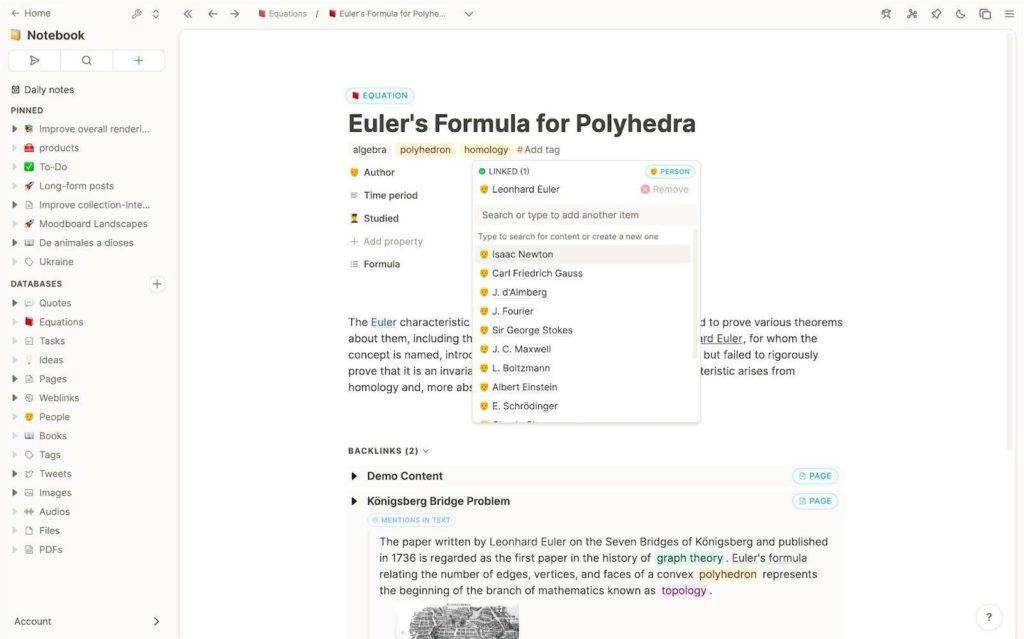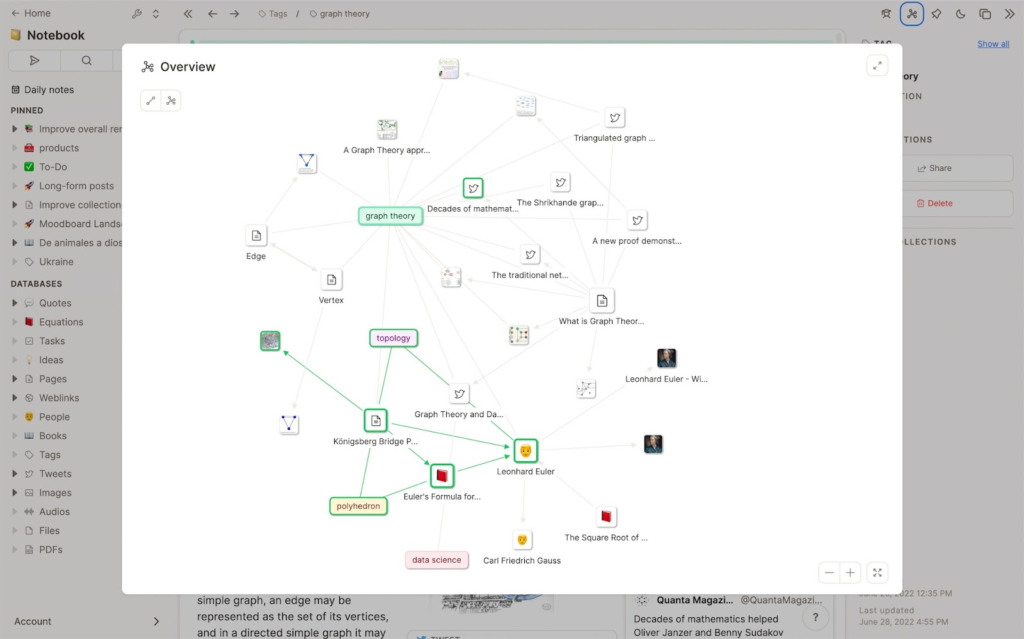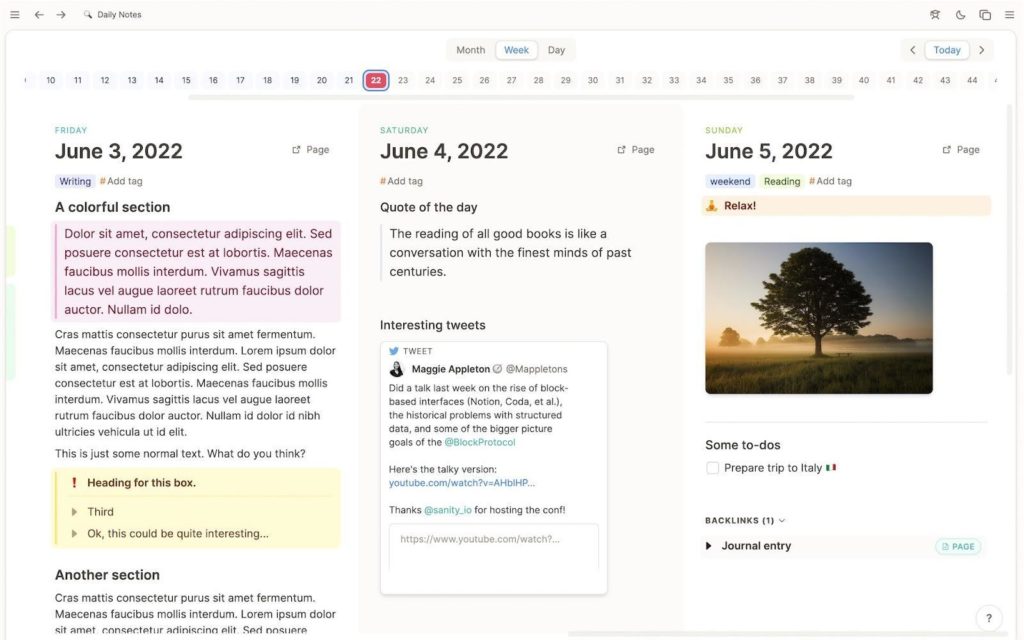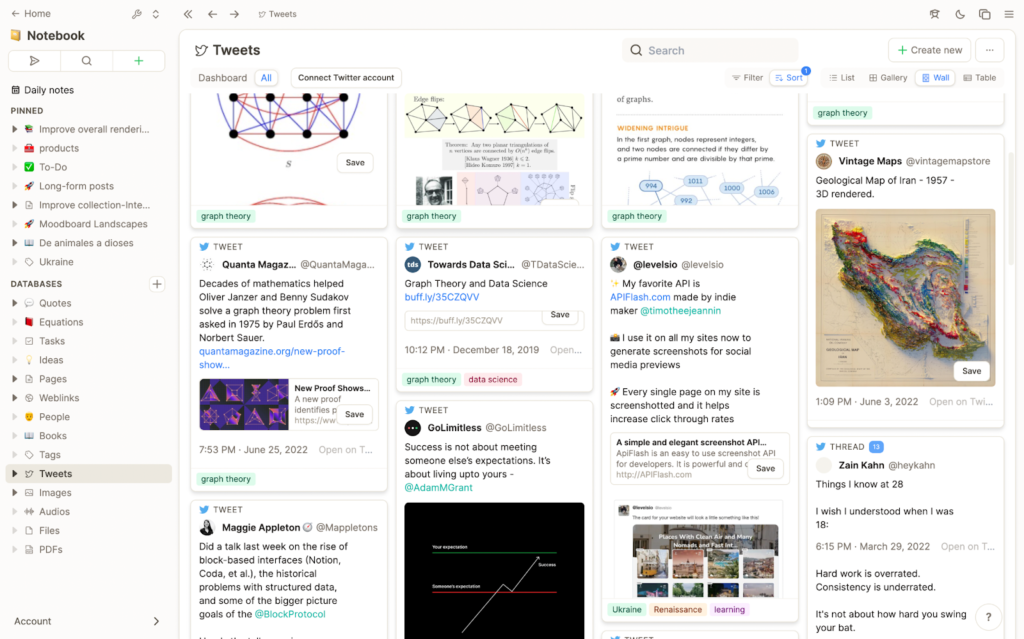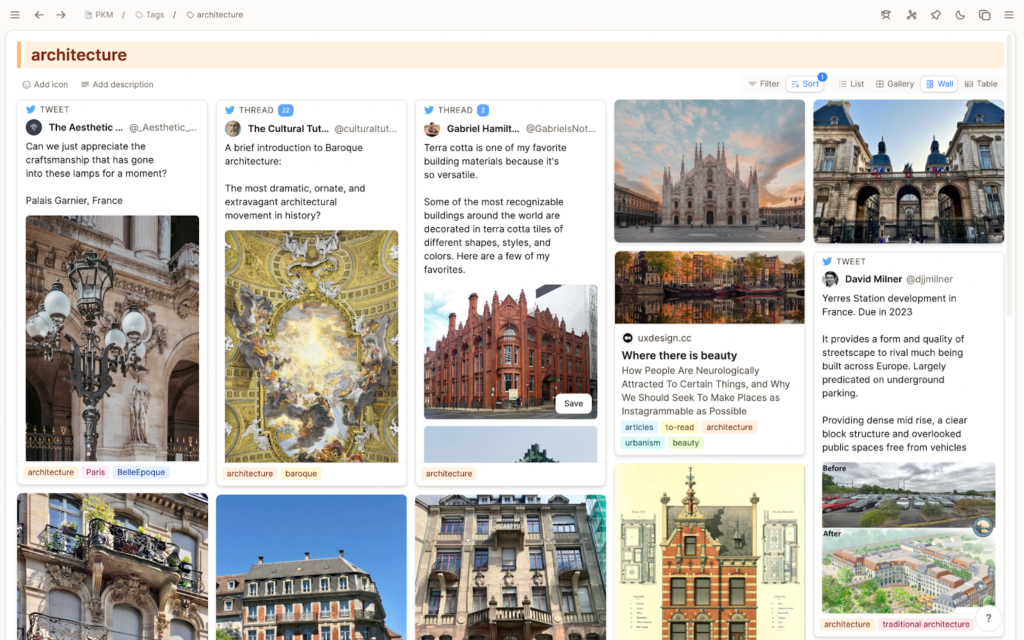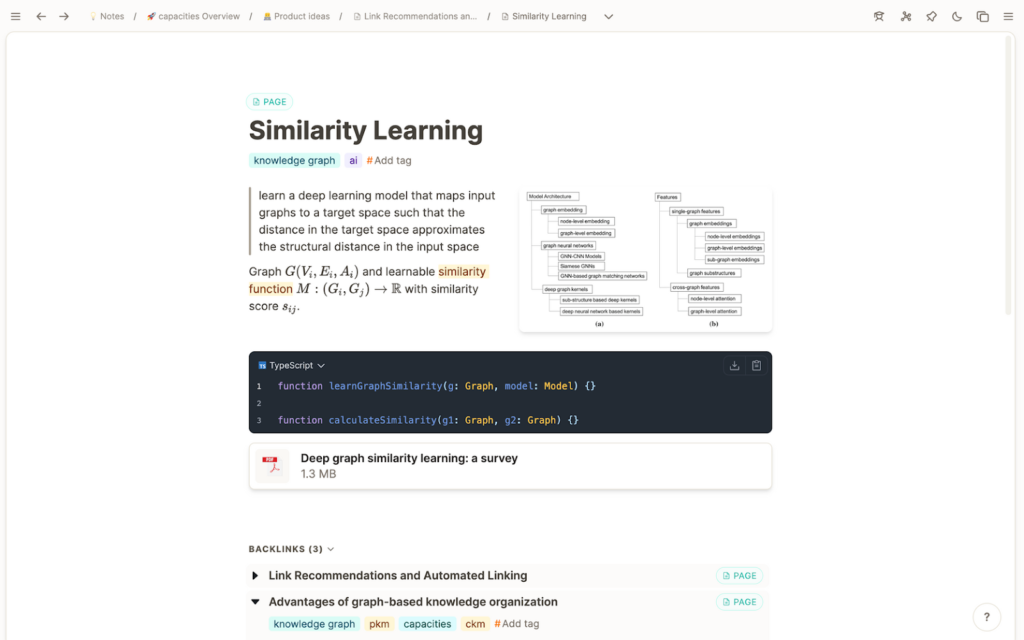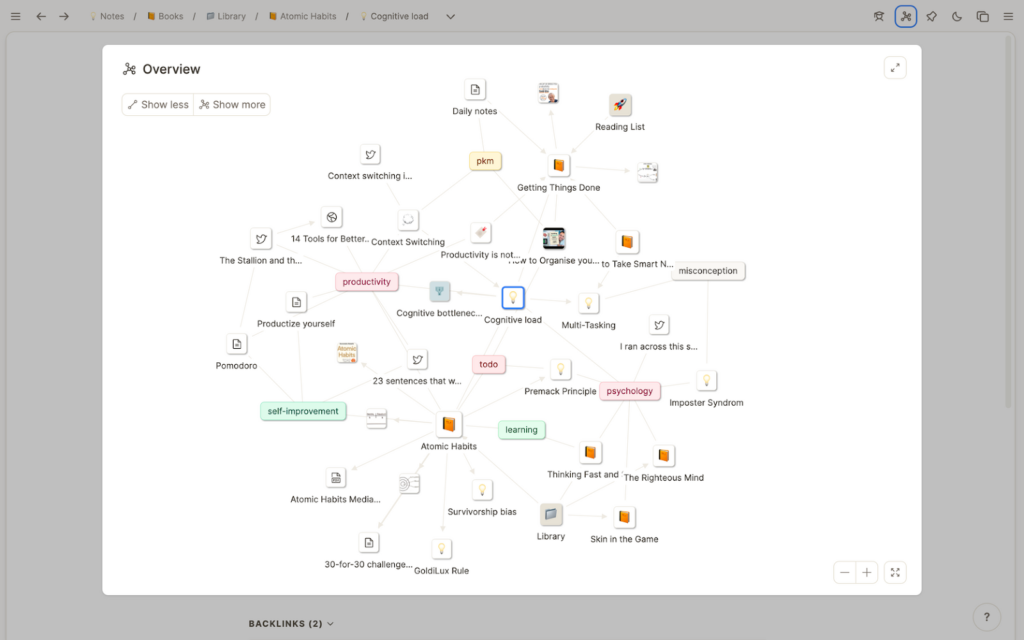Welcome to this edition of our Tools for Thought series, where we interview founders on a mission to help make the most of our thoughts. Steffen Bleher and Michael von Hohnhorst are the co-founders of Capacities, a graph-powered note-taking tool to save, connect, and organize ideas so you can be inspired and create lasting knowledge.
In this interview, we talked about the concept of a second brain, the analogy between cities and minds, how thinking in hierarchical categories limits our creative thinking, how we all are chronological thinkers, how to use tags to form a meta network of your content, and more. Enjoy the read!
Hi Steffen and Michael, thank you so much for agreeing to this interview. What inspired you to help people practice networked thinking?
We live in an age of information abundance — and an equal amount of distractions. The most popular apps today are designed like slot machines: Netflix, Instagram, TikTok. We stream and scroll for the dopamine to kick in. We consume like animals in a lab, not realizing that we’re trapped in a social media maze.
Yet, each one of us is trying to acquire a unique combination of specific knowledge — to create, to design or to invent. If we don’t want to drown in this flood of information, we have to take back control and create our own systems. A second brain is such a system. It’s the opposite of social media and news: it doesn’t control you, it empowers you. It’s a place without distraction — a studio for your mind.
The term “second brain” was developed and popularized by Tiago Forte. It’s a framework to organize your digital life. Building a second brain means creating an external structure with all your thoughts, ideas, interesting content and media, learnings and experiences. The externalization in itself structures your thinking. Furthermore, it’s explorable like your mind: you can search and browse your thoughts. It resurfaces your ideas and helps you discover new connections.
But we realized that creating such a system is really hard. When we looked for tools to do this, we couldn’t find anything that was built to tackle this challenge while still being simple to use and accessible to most of us. After some research we identified two major categories of apps that try to solve this problem.
On the one hand, there is the traditional approach of folders and tables (or databases). They appeal to a broad audience because they are simple to use. We are used to organizing information in folders because that’s how computers worked since we invented them. While folders and sheets create a robust structure to collect and organize they contradict our natural way of thinking.
Most ideas cannot be locked into a single box. We think in associations and relationships, one idea sparks another. That’s where the creative process takes place. After using these tools for a while, we found that they are somewhat blocking our minds: thinking in hierarchical categories limits our creative thinking.
On the other hand, we found a branch of tools that takes a radically different approach: you create documents and blocks from the bottom up and link them on the fly to any other document or block that might be related. The tool then allows you to browse these connections in both directions. These tools map our thinking but are difficult to use. Their interfaces look like code editors — not like places where we want to be creative. They appeal to a techy audience — but their complicated syntax and a myriad of plugins make them difficult to use for most of us.
We envisioned a tool that could solve this problem by combining the two approaches, a tool that becomes a natural extension of our mind and our personality. We both have a background in information theory and are connected by the excitement about information structuring and the power that can emerge from it. We combined this with our experience in artificial intelligence and user interface design.
After nearly one year of endless discussions, collaborations with learning research and AI institutes, and of course many cups of coffee we came up with a data model that provides a robust organizational structure but also lets you think and associate content in any imaginable way. At that point, Capacities was born.
Can you tell us how it works?
Let us take you on a journey through the concepts that define Capacities and explain how they can help you structure your digital life. Imagine a city where every building was exactly the same. I think we agree this isn’t a place you wanted to live in. Buildings have functions: offices are built to work in, houses are designed to live in, and theater halls are created to bring people together.
The same is true for our notes — they’re not all the same. Our minds are colorful. We think in terms of ideas, questions, people, or meetings. These notes have different purposes and properties. If all notes were the same we’d lose track and our note-taking would become monotonous very fast.
In Capacities, we call these different notes entities and every entity has a type. An image, for example, is a first-class citizen in Capacities, it’s a piece of content with its own properties such as a title, tags or notes – in short, an entity of type image. The same applies to bookmarks, tweets, or files.
Entities of the same type share the same structure and a design that differentiates them from other content and supports their function. Each type of entity gets its own database. For example, there’s a database where you will find all your images, tweets, or pages in one place. This gives you a great base level of organization for all your content.
In addition to these basic types you can create your own types with custom properties to adapt the system to your needs. You can for example define the type “Person” which has properties like profession, company, contact information, and notes. Or you can create a type “Meeting” which has a date, notes on what was discussed, follow-up tasks or a list of attendees — there are basically no limits.
These types make your note taking more colorful. You just create what you have in mind from everywhere within the app and the structure guides you in filling your entities with life.
Now back to our city: different types of buildings make the city much more colorful. But now imagine all office buildings would be in one place, all residential buildings in another and every building could just be reached from a single street. That would be unpleasant as well, at least for us as Europeans. You’d have to travel a lot every time you need something different.
That’s exactly the equivalent of using folders and tables to organize your thoughts. Every note lives at one place and you have to navigate to that location if you want to work on it.
In Capacities, all notes are interconnected. They don’t have a fixed location. Mathematicians call this structure a graph. Every entity is a node in a network and can be connected to others. And the most important thing: in Capacities, this happens by simply taking your notes.
When you create a meeting and add some attendees, they are all linked to that meeting, so once you open the page of a person you see all meetings you had with her. In the paper draft you’re working on you can directly embed ideas, or create questions, add PDF references or tags. When you browse through all your open questions you see where they were created and can quickly jump to that content. In your text you can quickly link to concepts and definitions you already created. When you come back to that definition in a few weeks you will see all text references at the bottom so you can quickly get an idea of the topic again.
This network becomes more powerful over time as more and more content is added. You can explore it when you want to get inspired. It helps you find connections you haven’t thought about. It might even spark an idea for your next project. Capacities becomes a super power for creative thinking.
Daily notes are a cornerstone of Capacities. Can you share a little bit more about your unique approach?
Next to types and the network of ideas, daily notes are actually the third fundamental pillar of Capacities. If you allow us to come back to our city metaphor once again this will become clear.
Beautiful cities grew over time. They change, adapt, and get reorganized. There are a lot of different time periods baked into the identity of a place. That’s the beauty of historic cities. Again, the same is true for your thinking. We all are chronological thinkers — time is a fundamental dimension of our learning process.
And that’s where daily notes come into play. For each day you get one note for whatever feels important on that day. It can be the place where you start working and then branch out from there. Every other entity you’ve created on a day is also displayed below the daily note so you automatically get a nice overview of all your work. Next to individual daily notes we provide weekly, and monthly views that allow you to zoom out — it’s like a calendar for your thoughts.
In your notes you can always reference a day, for example, by just typing “+today”. The current paragraph will then be shown as a backlink on today’s page of your calendar view. But this is just the beginning. We will integrate the time dimension more and more into your note-taking.
For example, we will add tasks as entities to Capacities that will be integrated in your daily notes dashboard, you will get daily statistics on your work and Capacities will resurface content based on time and context to help you create new connections, learn from your knowledge, and hopefully spark new ideas.
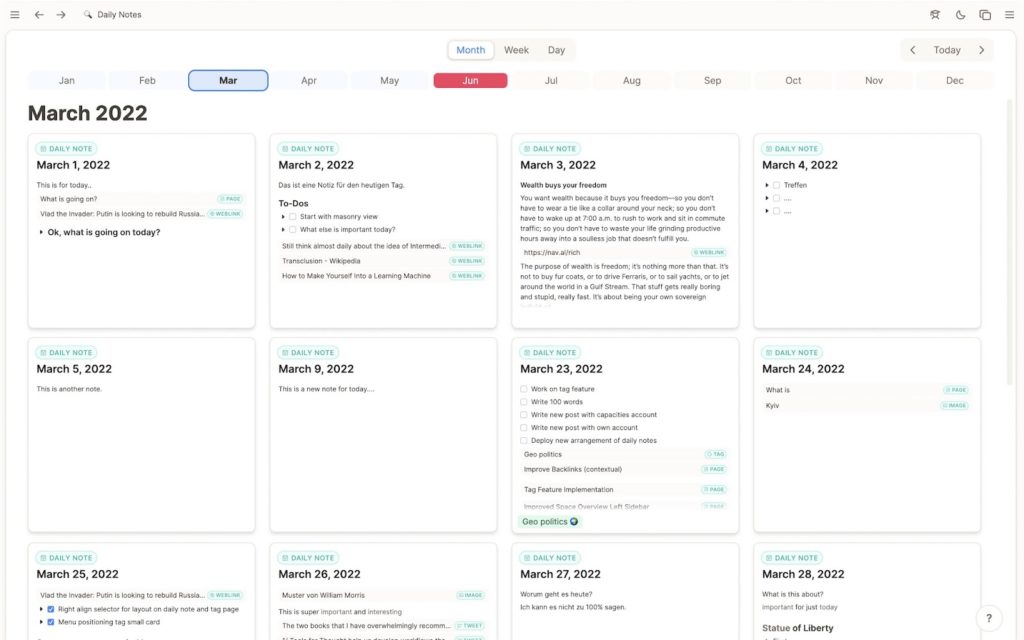
With so many types of digital content you support… How do you make it a smooth experience for Capacities’ users?
We believe that content types actually help you to get organized. Whenever you create a note, you most certainly know what type it will be: You want to add a question or you have a meeting. And by doing this you even reduce the cognitive load: a predefined structure tells you how your note should look like, and you know that it already gets organized in your databases and on your daily note — no matter where you create it.
On top, we made capturing ideas extremely simple. A lot of times you want to quickly capture thoughts while on the go, collect bookmarks while browsing on your phone or take a picture of something interesting. You can simply set up a chat with Capacities in WhatsApp or Telegram and send links, images, voice messages and thoughts to Capacities. You can even tag them from within the chat app. Capacities then analyzes all your inputs, enriches them with metadata, adds them to your databases and your daily note so you can process them when you have the time for it.
And from within the app working with media is very simple as well: Just paste links, images, PDFs, etc. and Capacities will add them to the correct database for you. If you paste the link of a tweet, the whole tweet becomes part of that entity and you can find it in your Tweets database.
Our vision is to make capturing as frictionless as possible, the barrier between your brain and Capacities should be minimal. At the moment we are working on a browser extension to assist you while researching on the internet and we have plans to integrate many other tools such as Readwise for your Kindle highlights, Google Drive for you files, or Zotero for annotations.
That might be a good time to also talk about tags. They are a simple but powerful way to organize your content — especially when it comes to media assets. In Capacities, any entity can be tagged. Over time you will build an extensive library of assets. When you click on a tag page you will get a beautiful curation of all content that is connected to that tag. All your tags form a meta network of your content that you can traverse and explore to see how all your ideas are connected.
How do you recommend someone get started with Capacities?
The best way to get started is to create an account, follow the onboarding and watch our introductory video. You can also just start working in a space filled with helpful content and resources that you can explore. In addition, we provide a detailed documentation including several tutorials to get you started as fast as possible.
After onboarding, we suggest starting with daily notes. Connect your favorite messenger to save images, links or text and connect Twitter to save tweets and threads. All your content will be added to your daily notes. You can start tagging it, or create collections of bookmarks for example.
After a while, you will observe what kind of content you mostly create and set up your first custom content types to adapt the system to your workflows. Just start using it and connect your content, the structure of Capacities will help you organize it.
If you have questions or want to exchange ideas with other users, feel free to join our Discord community. And of course, you can always send us an email and ask for help.
What kind of people use Capacities?
There is a large variety of people using Capacities. Many people use it as a professional tool to organize and create work-related content. But we also know of many users who use it for personal hobbies and interests, or as researchers or students.
Our users love how beautiful their notes look and often mention that custom content types give them a great structure to work with. They love how their content get’s curated on beautiful boards and that they are just able to link and reuse everything and everywhere.
What about you… How do you personally use Capacities?
We built Capacities because we were frustrated with the available tools. We both use Capacities to organize our life, to follow our interests and reflect on our learning journeys.
Michael: As a product designer, I use Capacities to collect great examples that inspire me. I mostly use screenshots that I paste into my daily notes together with tags such as #DesignInspiration and a more specific term such as #LandingPages or #UIComponents. Besides screenshots I also organize my bookmarks and PDFs of design resources this way.
I also have a daily routine of saving the best tweets and threads on Twitter to Capacities, which allows me to tag them by topic and review them regularly.
And of course, I do most of my writing in Capacities: drafts for social media posts, blog articles and some personal reflections.
On a recent trip I’ve been using the WhatsApp integration a lot to quickly add pictures of things that inspire me or new vocabulary to Capacities.
Steffen: We also use Capacities to build Capacities. It helps us to be creative and collect ideas and thoughts. Basically, Capacities helps us to come up with great ideas for Capacities — a positive feedback loop.
I organize a lot of my research papers on knowledge graphs, AI and algorithms in Capacities. I tag them, take notes on screenshots, PDFs or formulas. I sketch algorithms using the code editor in Capacities.
All the research I read and process about learning and cognitive science are organized in a huge interconnected network of small “zettels”, which are linked to PDFs, web articles and tags.
It especially helps me to explore this content visually. I just use the graph view to see related content, open tags to get inspired and to continue working on where I left off on my “todo” tag page.
And finally… What’s next for Capacities?
When we sit together in the evening with a cold German beer in our hand and discuss concepts and ideas for Capacities we sometimes look at each other, smile, and say: “We are just getting started”.
We have an incredible community of early supporters that love to work with Capacities. We interact with them on a daily basis and we invite everybody to join. Together with that community, we make Capacities better every day.
Capacities went into public beta just in January and we are currently moving with an incredible pace, mostly due to fundamental work we did on designing a data structure for Capacities. Only in the last two months for example we added the tag system, contextual backlinks, reworked our database system, added the daily note dashboard and integrated hundreds of user tickets.
We have a lot of ideas on our roadmap, like integrated task management or media annotations in PDFs, videos, and images. We are also working on more content types like quotes, zettels, and videos. The aspect of compatibility and having sustainable content is super important for our users. For this reason we are planning to build an extensive import/export system with support of common formats such as Markdown, CSV and JSON. We also want to further reduce the friction of adding content from other systems by developing more integrations such as Readwise or Zotero. You can get an overview on roadmap.capacities.io and participate under capacities.io/feedback.
Over time, we will extend Capacities to be a more and more intelligent tool. We want to support you with recommender algorithms that resurface content when you need it and help you learn in a way that’s fun and explorative. Capacities will suggest related content intelligently and help you to automate the organization of your digital information to remove any friction and help you create the results you want even faster.
Our long-term vision is to make learning, curiosity, and knowledge acquisition more social. As unique as each of our domains as note-takers might seem there are other like-minded people out there that work on similar ideas. We want to enable a culture of sharing and will give you the option to connect via your notes: matching you with people based on topics you both are interested in, allowing you to save parts of their public content to your spaces, and enabling you to share your best content with the world — everything from within Capacities, within a huge digital network of knowledge and ideas.
Thank you so much for your time, both of you! Where can people learn more about Capacities and give it a try?
Just go to our website and try it out. We also regularly post on Twitter with @capacitiesHQ and our personal accounts @steffenBle and @MvHohnhorst. You can also follow us on Instagram for more visual updates. And you are of course welcome in our newly created Discord community.

